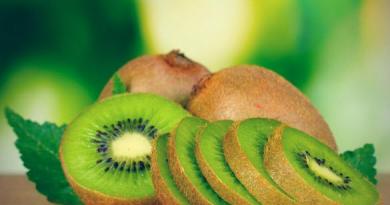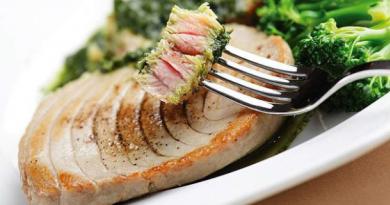Where do mushrooms grow and at what time to collect? What elements are contained in these mushrooms, how to cook them at home? Benefits, harms and ways to distinguish real mushrooms from "false" ones.
The content of the article:
Honey mushrooms (Armillaria) is the everyday name for a group of mushrooms belonging to different families. All of them have a common feature that lies in the name: most of them grow on stumps, a dead cut of wood. Due to the large number of subspecies, the description is vague, but almost all of them have a couple of common features: as they mature, a convex and then a flat hat, a long thin stem. They grow in large colonies, mostly in autumn. They are widely distributed throughout the world, absent only in the permafrost region. Honey mushrooms can be boiled, fried, stewed, pickled, salted, and even cooked mushroom seasoning or sauce.
Composition and calorie content of fresh mushrooms
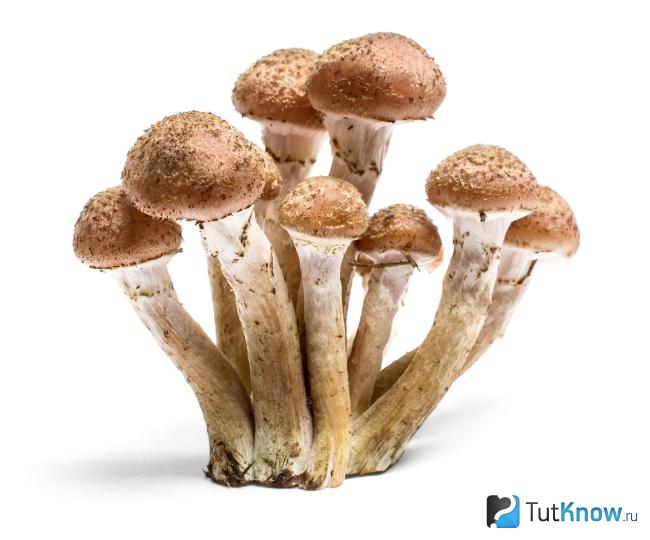
The composition of mushrooms includes more than 30 useful components, micro- and macroelements, which allow you to replenish the daily dose of many substances.
Caloric content of fresh mushrooms - 22 kcal per 100 g of product, of which:
- Proteins - 2.2 g;
- Fats - 1.2 g;
- Carbohydrates - 0.5 g;
- Water - 90 g;
- Ash - 1;
- Organic acids - 0.9 g.
- Potassium - 400 mg;
- Calcium - 5 mg;
- Magnesium - 20 mg;
- Sodium - 5 mg;
- Phosphorus - 45 mg.
Vitamins per 100 g:
- Thiamine - 0.02 mg;
- Riboflavin - 0.38 mg;
- Ascorbic acid - 11 mg;
- Alpha tocopherol - 0.1 mg;
- Vitamin PP, NE - 10.7 mg;
- Niacin - 10.3 mg.
Mushrooms are low in calories, so they can be used in diets. Raw mushrooms vaguely resemble herring in smell, while fried mushrooms have a taste and smell of meat. 2-methyl-3-furantiol, a component of fried meat, is responsible for this process.
Useful properties of mushrooms
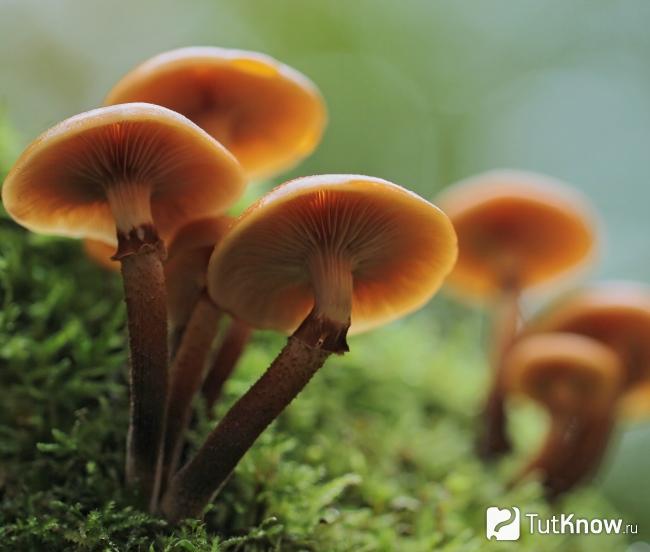
This type of mushroom is a natural antiseptic, along with antibiotics or garlic, it helps to treat E. coli or Staphylococcus aureus. Riboflavin in their composition is responsible for healthy and clean skin.
The benefits of mushrooms and dishes with their content:
- Accelerate redox reactions, which increases the susceptibility of color and improves "twilight" vision;
- Promote oral health, strengthen gums;
- Due to the high content of vitamin C, they strengthen the immune system;
- They accelerate blood formation and increase hemoglobin, it is recommended to take it for various types of anemia, complex blood clots, leukemia;
- Inhibit the development of tumors: the nervous system, breast cancer, sarcoma;
- They are used with support for diabetes mellitus, as well as liver diseases;
- Strengthen bones and bone tissue;
- Have a beneficial effect on the hormonal system (thyroid gland);
- Help in the treatment of eczema and psoriasis;
- In terms of phosphorus content, they can compete with some types of river and sea fish, therefore, with individual intolerance to the latter, mushrooms can be added to food.
Harm and contraindications to the use of honey mushrooms

The consequences of the abuse of honey mushrooms:
- Digestive problems. Like all mushrooms, mushrooms belong to the category of “heavy” and difficult to digest food, which, if consumed in moderation, can lead to some problems of the gastrointestinal tract (gastrointestinal tract).
- Diarrhea. In persons suffering from minor disorders of the digestive system, when using large portions of mushrooms.
- Poisoning. Honey mushrooms have a certain cooking schedule (time, temperature), non-compliance with it often leads to poisoning.
- Toxins and radionuclides. Honey mushrooms easily mutate under the influence of the environment, so you need to carefully choose the place of collection or buy only from trusted and reliable suppliers.
- Diseases of the gastrointestinal tract. Pickled mushrooms, although they are a delicious product, contain a large amount of vinegar, the excessive use of which can even lead to stomach ulcers.
- Botulism. Improper preservation of mushrooms can lead to this rather rare disease. 90% of cases of botulism occur precisely because of a violation of the technology of conservation of mushrooms.
- "False mushrooms". With extreme caution, you need to collect this type of mushroom, as there are similar, but poisonous mushrooms, the use of which leads to much more serious consequences than all of the above.
Absolute contraindications to mushrooms:
- Exacerbation of any diseases of the digestive system - leads to a severe course of the disease, which requires additional medical intervention.
- Remission of diseases of the gastrointestinal tract - mushrooms can provoke the resumption of the disease.
- Diseases of the liver and kidneys - they are responsible for the production of gastric enzymes that break down foods, so eating mushrooms will lead to regular indigestion.
- Gout - due to the high concentration of purine, mushrooms can provoke a deterioration in the condition.
- Mushrooms should not be eaten by children under ten years of age: the stomach lacks the necessary enzymes that allow mushrooms to be processed normally.
Of course, the harm of honey mushrooms can only manifest itself in case of improper cultivation, choice of the place of collection, preparation, or in case of diseases and intolerance to the product. In all other cases, this is a tasty and healthy product, which, at least as an experiment, should be included in your menu.
Honey mushroom recipes
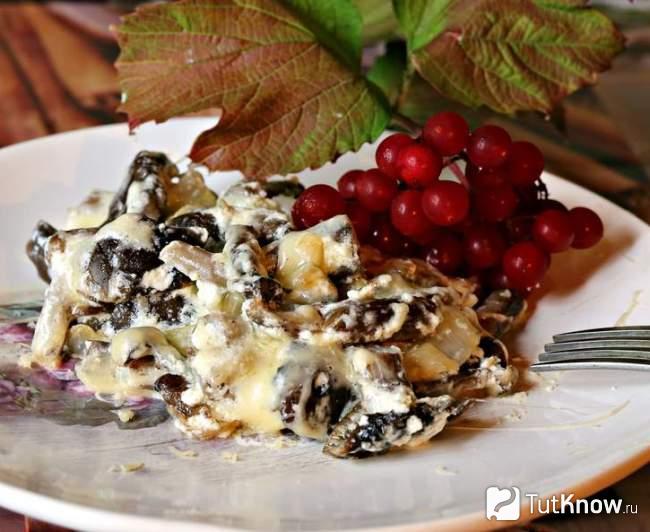
Many people ask questions about how mushrooms are eaten and how to cook them properly. In many ways, they are convenient in cooking: you don’t have to spend a lot of time slicing, since the mushrooms themselves are small. Boiled, pickled, salted and fried, they go well with potatoes, boiled rice, pasta, herbs. Chopped mushrooms can be added to minced meat for subsequent frying.
We have selected for you some healthy and tasty recipes from fresh mushrooms:
- Honey mushrooms baked with potatoes. Portion is for 4 people. Rinse 500 grams of mushrooms well in running water, boil in salted water for 30 minutes, drain the liquid, cool. Peel 1 kg of potatoes, cut into circles, add black ground pepper (you can use allspice), salt. Peel onion (150-200 grams), cut into medium rings or half rings. Put finished products in layers, sprinkle with herbs on top, pour sour cream (200 ml), sprinkle with hard grated cheese (150-200 grams). Bake for 40-50 minutes in the oven at 180 degrees.
- Stewed mushrooms with sour cream and onions. Peel and rinse 1 kg of mushrooms, cut large ones into small pieces, boil in salted water for 20 minutes. Pour into a colander, let cool. Onion (150 grams) peeled, cut into cubes. Melt the butter (200 grams) in a frying pan, fry the onion on it until golden brown, add the mushrooms, fry for 5 minutes, stirring occasionally. Add 500 ml of sour cream to mushrooms and onions, add salt to taste, ground black pepper, slightly dilute the sour cream sauce with boiled water if the sour cream is thick. Cook until the onion is no longer crispy and the sour cream is no longer creamy. Serve with fresh herbs and boiled potatoes. To reduce the calorie content of the dish, try replacing sour cream with unflavored yogurt, and potatoes with boiled rice.
- Julienne with fried mushrooms. Boil chicken fillet (500 grams), cut into small cubes (for a richer taste, boil immediately in boiling water, add salt). Onion (250 grams) and honey mushrooms (300-350 grams) cut into medium-sized cubes. Fry it in vegetable oil until golden brown, add mushrooms and fry until the liquid is completely boiled away. Pour chopped chicken fillet into the resulting mixture, salt, pepper, remove from heat. In a dry frying pan, fry 2-3 tablespoons of flour for 3 minutes, add cream or sour cream (300 grams), seasonings and, stirring, cook until cooked (boil). Add the fillet, onion and mushrooms to the resulting mixture, mix, remove from heat. Put the finished mass in cocottes (clay or ceramic pots for the oven), sprinkle with grated cheese, bake in the oven at 180-200 degrees until an average crust is formed (about 20 minutes).
- Cutlets from mushrooms and beef. Boil 500 grams of mushrooms in salted water for 40 minutes. Drain into a colander, let cool. Mushrooms, 500 grams of beef and 2 peeled onions, pass through a meat grinder. Salt, pepper, add a little greenery if desired. Crack in 2 eggs and mix thoroughly. Form balls with wet hands, fry in hot vegetable oil until fully cooked.
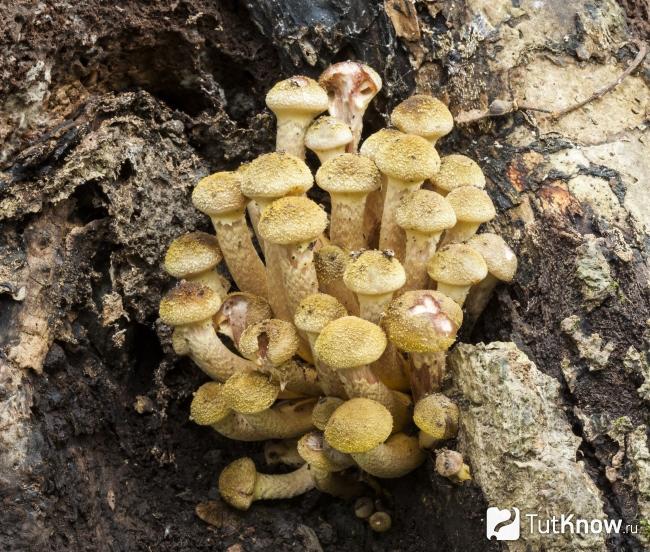
Honey mushrooms grow in a “ring”, this has led to a common misconception that “honey mushrooms” are translated from Latin as “bracelet”, and this, in turn, gave rise to a myth about the origin of the name of this mushroom. In fact, honey agaric owes its name solely to the place of growth - on the stumps of trees. Although, despite this, honey mushrooms process trace elements from any part of the tree, whether it be the foot, trunks, even fallen branches.
There are more than 10 types of mushrooms, but on the shelves of our stores, as a rule, we meet only a few of them: autumn and winter. Autumn, they are also Armillaria mellea, the most tenacious, as they have adapted to grow in the most difficult conditions. Winter mushrooms (Flammulina velutipes) grow exclusively on weak or dead deciduous trees. They have a certain amount of unstable toxins in their hat, so they must be more carefully subjected to heat treatment.
It was the winter species that were used in most studies again as a medicinal material. They are used as a remedy for many diseases in folk medicine - fungotherapy. So, for example, it is believed that a compress of them helps to remove warts, and a tincture eliminates infertility and problems with the thyroid gland.
Due to the need for long heat treatment, mushrooms in many European countries are considered conditionally edible or completely unsuitable for consumption. So, in England, they use only mushroom caps.
Along with edible mushrooms, there are “false” ones that can be distinguished by some signs:
- Edible mushrooms, in addition to winter mushrooms, have a “skirt” under the hat.
- "False" mushrooms have an unpleasant earthy smell.
- Hats differ: edible - scaly structure and soft (light brown) color, "false" - smooth and bright.
- Differences in the color of the plates under the cap: in edible mushrooms they are cream or white with yellowness.
The popularity of mushrooms is explained by their relatively low price, as well as ease of transportation: they are perfectly springy and do not break, which allows them to reach the original form from the "bed to the table". In addition, they tolerate freezing well, without losing many useful substances.


